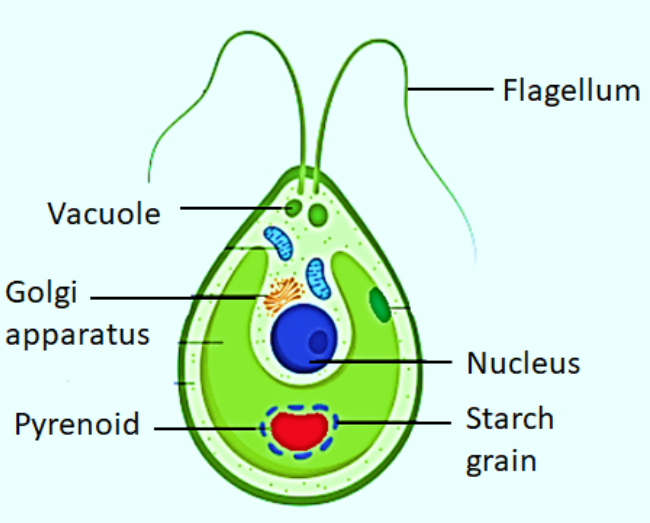
Which one of the following is a unicellular, freshwater algae?
(a) Spirogyra
(b) Monodus
(c) Chlamydomonas
(d) Vaucheria
Answer
577.2k+ views
Hint: They are plant-like autotrophs having chlorophyll. They are closely related to the evolution of land plants. They contain ion channels named channelrhodopsin which is directly activated by light.
Complete Answer:
A) Spirogyra: It is a multicellular and filamentous green algae that are generally found in freshwater habitat. It has a helical or spiral arrangement of the chloroplast.
B) Monodus: It is a microalgae which is found in marine habitat. It has potential uses in functional food.
C) Chlamydomonas is a unicellular flagellate that is widely present in freshwater or damp soil. It contains red eye spots for photosensitivity. The cell wall of Chlamydomonas is made up of a glycoprotein and non-cellulosic polysaccharides instead of cellulose. Chlamydomonas asexually reproduces by zoospores, hypnospores, or a palmella stage. However, sexual reproduction occurs by isogamy, anisogamy, or oogamy.
- Isogamy: It involves the fusion of gametes in similar sizes.
- Anisogamy: It involves the fusion of gametes in dissimilar sizes.
- Oogamy: It involves the fusion of large, immotile female gametes with small, motile male gametes.

Algae include various groups of photosynthetic organisms that are found in a wide range of habitats, aquatic as well as land. The unicellular algae are divided into different groups:
1) Euglenophyta: They are flagellated unicellular organisms that are mainly found in freshwater. They lack cell walls and can be mixotrophic i.e. autotrophic and heterotrophic both.
2) Chlorophyta: They are also unicellular organisms that present in freshwater. They are more closely related to the evolution of land plants. They are green in color due to the presence of chlorophyll and make their food by photosynthesis.
3) Diatoms: They are unicellular and have siliceous cell walls. These organisms are most abundant in the ocean. They constitute about 40% of the world's primary marine production and generate about 25% of the world's oxygen.
4) Dinoflagellates: They are flagellated unicellular algae. They are mixotrophic and are responsible for red tide. Some dinoflagellates such as Pyrocystis fusiformis, are capable of bioluminescence.
D) Vaucheria: It is a multicellular yellow-green algae. Most of the species are found in freshwater while some are marine.
So, the correct answer is ‘Chlamydomonas’.
Note: -Chlamydomonas is generally found in a habitat that is rich in ammonium salt.
-Chlamydomonas is used as a model organism in molecular biology.
-Instead of cellulose, their cell wall is made up of glycoprotein and non cellulosic material.
Complete Answer:
A) Spirogyra: It is a multicellular and filamentous green algae that are generally found in freshwater habitat. It has a helical or spiral arrangement of the chloroplast.
B) Monodus: It is a microalgae which is found in marine habitat. It has potential uses in functional food.
C) Chlamydomonas is a unicellular flagellate that is widely present in freshwater or damp soil. It contains red eye spots for photosensitivity. The cell wall of Chlamydomonas is made up of a glycoprotein and non-cellulosic polysaccharides instead of cellulose. Chlamydomonas asexually reproduces by zoospores, hypnospores, or a palmella stage. However, sexual reproduction occurs by isogamy, anisogamy, or oogamy.
- Isogamy: It involves the fusion of gametes in similar sizes.
- Anisogamy: It involves the fusion of gametes in dissimilar sizes.
- Oogamy: It involves the fusion of large, immotile female gametes with small, motile male gametes.

Algae include various groups of photosynthetic organisms that are found in a wide range of habitats, aquatic as well as land. The unicellular algae are divided into different groups:
1) Euglenophyta: They are flagellated unicellular organisms that are mainly found in freshwater. They lack cell walls and can be mixotrophic i.e. autotrophic and heterotrophic both.
2) Chlorophyta: They are also unicellular organisms that present in freshwater. They are more closely related to the evolution of land plants. They are green in color due to the presence of chlorophyll and make their food by photosynthesis.
3) Diatoms: They are unicellular and have siliceous cell walls. These organisms are most abundant in the ocean. They constitute about 40% of the world's primary marine production and generate about 25% of the world's oxygen.
4) Dinoflagellates: They are flagellated unicellular algae. They are mixotrophic and are responsible for red tide. Some dinoflagellates such as Pyrocystis fusiformis, are capable of bioluminescence.
D) Vaucheria: It is a multicellular yellow-green algae. Most of the species are found in freshwater while some are marine.
So, the correct answer is ‘Chlamydomonas’.
Note: -Chlamydomonas is generally found in a habitat that is rich in ammonium salt.
-Chlamydomonas is used as a model organism in molecular biology.
-Instead of cellulose, their cell wall is made up of glycoprotein and non cellulosic material.
Recently Updated Pages
Master Class 12 Business Studies: Engaging Questions & Answers for Success

Master Class 12 Economics: Engaging Questions & Answers for Success

Master Class 12 English: Engaging Questions & Answers for Success

Master Class 12 Maths: Engaging Questions & Answers for Success

Master Class 12 Social Science: Engaging Questions & Answers for Success

Master Class 12 Chemistry: Engaging Questions & Answers for Success

Trending doubts
Which places in India experience sunrise first and class 9 social science CBSE

Fill the blanks with the suitable prepositions 1 The class 9 english CBSE

Write the 6 fundamental rights of India and explain in detail

Difference Between Plant Cell and Animal Cell

What is pollution? How many types of pollution? Define it

What is the full form of pH?




